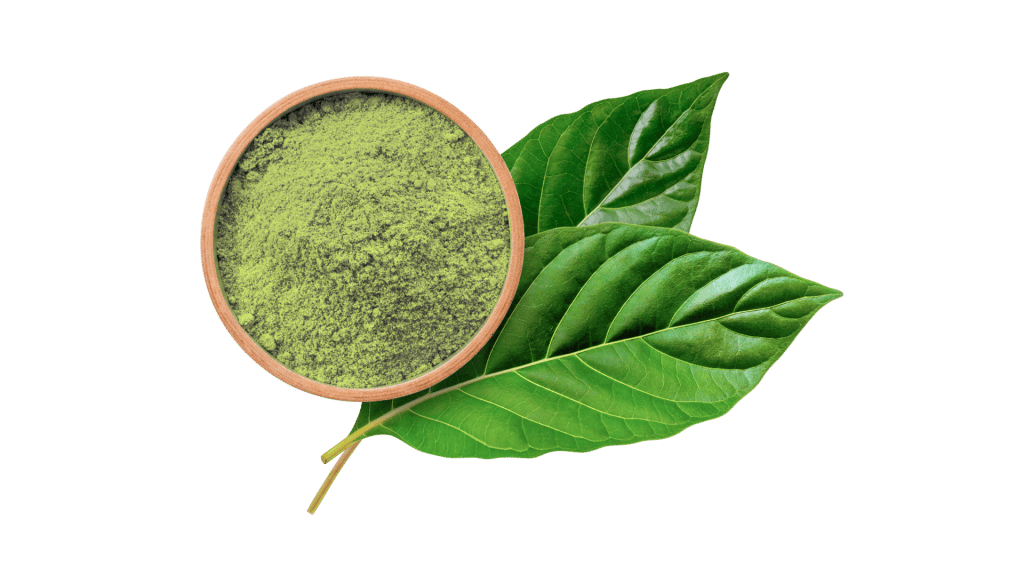Breakdown of Kratom Tea’s Nutritional Profile
Regarding macronutrients and minerals, kratom tea is a very mild substance. It contains very few of these compounds, which can be good or bad, depending on your goals. If you’re interested in kratom for its pharmacological benefits but don’t want to consume too many extra calories or want to keep tight control over your macros, then you’re in luck! However, if you’re turning to kratom to supplement your essential minerals, you might want to look elsewhere.
Kratom Tea Nutritional Table
These are the nutritional values you can expect in a 2-gram serving of kratom:
| Nutrient | Value Per 2 Gram Serving | Value Per 10 Gram Serving |
| Carbohydrates | 0.2 mg | 1.0 g |
| Protein | 1.5 mg | 7.5 g |
| Fats | <0.1 mg | Less than 0.1 mg |
| Sodium | <0.1 mg | Less than 0.1 mg |
| Iron | 0.5 mg | 2.5 mg |
| Calcium | 13.2 mg | 66.0 mg |
| Potassium | 18.5 mg | 92.5 mg |
As you can see, kratom has a negligible amount of protein, fats, and carbohydrates and only a limited amount of other essential nutrients. In fact, the only cause for concern when it comes to kratom’s nutritional content is the amount of iron. Heavy daily doses of kratom (around 16 g or more) could potentially lead to health problems. However, the body does not absorb plant-based sources of iron as easily as it absorbs the iron in meat. This factor alleviates the iron risk factor in kratom consumption considerably.
These estimates are based on kratom tea; other methods, such as raw leaves, tinctures, or capsules, could alter these numbers.
Based on what we know, kratom consumption appears to be negligible in calories. One source suggests that a 2-gram serving of kratom will have around 7.4 calories. However, My Fitness Pal, a tool used to count calories and macronutrients in many foods, suggests that one gram of kratom is free of calories, carbohydrates, fats, and proteins.
As we’ve said, due to the limited amount of research, it’s hard to know who is right. What can be said is that in both cases, the nutritional value of kratom appears to be quite limited.

Calories in Kratom Tea
Kratom is almost all fiber, which does have calories, suggesting a higher calorie count, except that the body finds fiber almost indigestible and does not absorb the caloric energy. Technically, you could ingest around 50 calories per ounce of kratom, but your body would absorb only 10-20 percent of the calories.
Looking at anecdotal evidence of people counting calories and attempting to lose weight on kratom, we can see that kratom consumption had virtually no effect on their results. This again suggests that the calorie count in kratom is minimal. Additionally, this type of fiber is known to have great intestinal benefits. It can pass through your gastrointestinal tract, promoting proper bowel movements and helping to clear the body of waste.
Micronutrients in Kratom
The scientific research determining the micronutrients in kratom is minimal. But we can still make some reasonable inferences based on what we know about how micronutrients behave concerning plant composition.
Several studies have determined that all sorts of leafy green plantlife (AKA shrubs and trees and the like) collect their nutritional value from the soil they’re grown in. If we look at the soil composition of kratom-growing countries in Southeast Asia like Thailand, Indonesia, Malaysia, and Myanmar, we could better understand what we’re dealing with.
With said research still lacking, we can turn to other studies, which suggest that in almost every plant, the following vitamins can be found [1]:
- Vitamin A
- Vitamin B1
- Vitamin B2
- Vitamin B5
- Vitamin B6
- Vitamin C
- Vitamin E
- Vitamin K1
- Calcium
- Iron
- Magnesium
- Phosphorous
- Potassium
- Sodium
- Zinc
Scientific research suggests that almost all types of leafy greens contain these minerals, along with omega acids and other compounds. Kratom tea is essentially ground-up plant matter, so we can reasonably assume that there are some amount of these vitamins in it.

Alkaloids & Other Related Compounds
Kratom’s various alkaloids cause its pharmacological effects. You’ve likely heard of the alkaloid mitragynine and its “cousin” compound 7-hydroxymitragynine. These two compounds are fundamental to kratom’s alkaloid profile, with mitragynine being solely native to the kratom plant. There are over 40 different alkaloids present in kratom [2].
Kratom also contains several other phyto- and micronutrients that could potentially add to its pharmacological effects. For instance, flavonoids belonging to the flavan-3-ols subcategory like epicatechin have been identified [3]. This compound has widely recognized properties like reducing blood glucose levels in diabetics and anticancer and antioxidant effects.
Other types of compounds, such as terpenoid saponins, polyphenols, and glycosides, have also been found in kratom [3]. Unfortunately, further research is needed to identify what possible pharmacological and nutritional value they might have. However, we know that some of these compounds, such as polyphenols and flavonoids, have generalized health benefits. Flavonoids, for example, are known to contribute to antimicrobial activity and the elimination of free-radicals — unstable atoms known to contribute to cancer. In general, the more we look into kratom, the more complex and widespread its potential health applications become.
The State of Kratom Research in the United States
If you’re an avid kratom consumer, chances are you’re well aware of the many legal and regulatory difficulties kratom is currently undergoing in the US. Due to kratom’s effects on the body’s opioid receptors and its potential to cause physical dependence, the FDA has sternly advised against its use, refused to recognize any of its legitimate uses, and taken several steps to limit kratom importation and consumption.
Additionally, the DEA has even announced its intention to classify kratom as a Schedule I drug — a category supposedly reserved for compounds with no medical usage and a high potential for abuse. However, the World Health Organization has reviewed kratom and found it is not dangerous — a decision that could impact future legislation for the better.
Among the worst consequences of this unjust governmental campaign have been the refusal to regulate kratom, which puts consumers at risk, and the hobbling of scientific research on kratom. In practice, this means that even though there is some legitimate research and logical inferences we can come to about kratom’s nutritional value, we should also be well aware that a lot more investigation is needed.
But it’s not all bad news. Recently, some states have signed the Kratom Consumer Protection Act. This bill requires kratom products to meet higher standards of purity and labeling requirements, as well as limit sales to those under the age of 21. If groups like the America Kratom Association can successfully lobby even more states to pass legislation of this sort, then the state of kratom legality and research could shift quickly.
Related: Clearing the Air: Kratom Myths & Misconceptions

What’s the Nutritional Value of Kratom?
For the time being, it seems that kratom has limited nutritional value in terms of the number of essential vitamins that it can add to a person’s diet. However, it does provide nutritional value in other ways.
Kratom’s leaves appear to have different phyto- and micronutrients, which have many beneficial properties. We need more research to isolate, identify, and study the various nutritional compounds in kratom, such as flavonoids and polyphenols.
- Edelman, M., & Colt, M. (2016). Nutrient value of leaf vs. seed. Frontiers in Chemistry, 4, 32.
- Meireles, V., Rosado, T., Barroso, M., Soares, S., Gonçalves, J., Luís, Â., … & Gallardo, E. (2019). Mitragyna speciosa: clinical, toxicological aspects and analysis in biological and non-biological samples. Medicines, 6(1), 35.
- León, F., Habib, E., Adkins, J. E., Furr, E. B., McCurdy, C. R., & Cutler, S. J. (2009). Phytochemical characterization of the leaves of Mitragyna speciosa grown in USA. Natural Product Communications, 4(7), 1934578X0900400705.









